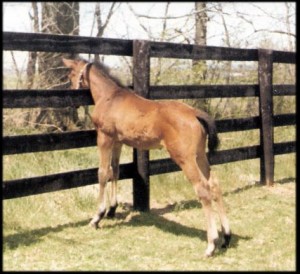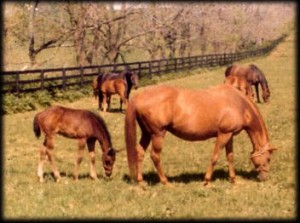The Place Dreams Come True by Karen A. Lynch
 Lexington, Kentucky is a place dreams come true. I know this, because I was living my dream there. How else to explain the experience of driving down Old Frankfort Pike on a beautiful spring day, passing fence row after fence row of fields with beautiful horses, their newborn foals alongside them, romping in the richness of the bluegrass?
Lexington, Kentucky is a place dreams come true. I know this, because I was living my dream there. How else to explain the experience of driving down Old Frankfort Pike on a beautiful spring day, passing fence row after fence row of fields with beautiful horses, their newborn foals alongside them, romping in the richness of the bluegrass?
My destination was Houyhnhnm Farm. Perhaps you will remember Houyhnhnm as the name of a breed of intelligent horses that author Jonathan Swift’s Gulliver encountered in the last part of the satiric story Gulliver’s Travels. It was a tongue-twister of a name until I learned that it was pronounced whin-em, which is what the owners of the farm to which I was heading, hoped that the horses they raised would do, both on the racetrack and in the show ring.
Lexington is the center of the world’s Thoroughbred and Standardbred horse breeding industry. It was my dream to rise to the top of the Thoroughbred industry. A lofty ambition given I was not a blue-blooded Kentuckian, whose families have been steeped in the tradition of Thoroughbred breeding for centuries. Although I had the qualifications and experience to succeed, I was an outsider, a transplant from northern Ohio, and female, another oddity in the business.
I now had a foothold in my dream thanks to an Oklahoma oilman, who had entrusted his Thoroughbred breeding operation to my care. I had chosen Houyhnhnm as the place to keep his horses until I could secure a farm of my own.
Houyhnhnm had a mix of Thoroughbred horses, those that race on the flat or over fences, and Standardbreds, who race while pulling a two-wheeled cart called a sulky. For the most part, Thoroughbreds are known for their beauty, while Standardbreds, since the time of their inception and because of their ancestry, have been thought of as plain looking. Standardbreds are bred to have two special gaits, a very fast trot (Trotters) and a gait that involves the horse moving both legs on the same side at the same time, referred to a pacing, Pacers have a very awkward way of moving, giving the impression of listing from side to side as they travel across the ground.
My attention was drawn to a particular colt. He stood out from the others because he was always alone. It was apparent right from the start that though they meant him no harm, the rest of the herd paid little, if any, attention to him. He was obviously an orphan.
He was sweet, but very plain looking and, because he was bred to pace, he moved anything but gracefully. Every day I would check up on him when I came to visit my client’s horses. Most of the foals were still at an age that they clung to their mother’s side. The orphaned colt took his meals with the other foals in the creep feeder, a special enclosure build to allow the foals in to eat, while keeping the mares out. They all had enough to eat, but the other foals still had the additional luxury of feeding from their mother and the comfort of her care.
It was obvious that the orphaned foal was lonely and sad. He stayed close enough to be protected by the herd, but far enough away so as not to incur the wrath of the mares that were not open to the idea of taking on a second foal.
A month passed, and still the orphaned colt made little progress at becoming one of the herd. Then came the summer heat, and with it the scourge of flies. While the other foals stood alongside their mothers blissfully fly-free thanks to her tail, the orphaned colt had to do his best with only the whiskbroom of his own tail.
Eventually, the other foals formed friendships with each other and played the usual horsy games of tag and race you to the fence. When tired, or hungry, they had their mothers to run to for a meal, a sweet lick on the back, or a tooth scratching on the rump.
 The orphan stood alone, wearing the saddest of wistful expressions. Was he, perhaps, dreaming of being fully accepted by the others as one of the herd?
The orphan stood alone, wearing the saddest of wistful expressions. Was he, perhaps, dreaming of being fully accepted by the others as one of the herd?
There was one Thoroughbred mare my client owned that I especially liked. Her name was Highland Hills. She was very well bred, being a half-sister to the great Sword Dancer. She was also the sweetest, kindest of mares and really beautiful, her coat a rich, chestnut color. By her side was her equally handsome, chestnut foal, a colt by the very good racehorse, Little Current.
This colt had taken to playing games with the others. One day, as I watched, the orphaned colt, caught up in the moment, tried to join in a racing game. Because he paced instead of galloped, he was quickly left behind. I saw Highland’s colt look over his shoulder, and a very curious thing happened. Instead of running on, he galloped back to the orphaned colt, turned and slowed his gallop to match the orphaned colt’s pace. It was a gesture of friendship not lost on me, or the orphaned colt.
After that, the two buddies romped around the field together. You could see the difference in the behavior of the orphaned colt, now happy to have a friend, though always when the time came, Highland’s colt would return to his mother’s side and the orphaned colt would once more be on his own.
One day, the flies were particularly bad. I watched the two colts romp around the field together. Then, as usual, Highland’s colt joined his mother for the comfort provided by her tail. Soon, I saw that the flies had become too much for the orphaned colt. Risking all, he cautiously moved up until he was positioned, face to the rear, on Highland Hill’s unoccupied side.
I saw her look around at the intruder and wondered what her reaction to him would be. Then, I saw her long, think tail, which had, up to then, been swishing only to the side that her colt was standing, begin to swish in both directions, and she lowered her head to the ground and began to eat.
Now the orphaned colt had two friends. Each day the two colts would play together. Then, when Highland’s colt went back to his mother, the orphaned foal would also happily stand alongside her, glad of her protection from the flies.
One day, again as I watched, he took his gamble one step farther. When Highland’s colt had finished feeding from her, the orphaned colt gave it a try. I guess I should not have been surprised that Highland let him. Now the two friends were brothers.
I was not alone in finding a place where dreams could come true.
©Karen Lynch. All rights reserved.
Photograph by Karen Lynch
Floyd the Dog has donated 46.18 Euros (US$56.67 UK£38.33) on behalf of Karen Lynch to “Cause for Paws”, Florida, U.S.A.
First published by www.floydthedog.com
